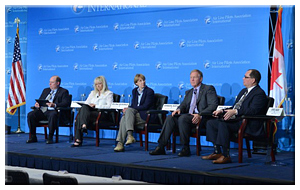| Having the Right Tools When You Need Them Most
 August
6, 2014 - Imagine that you are a pilot on a routine flight
from Chicago to New York, somewhere over Lake Erie.
Suddenly, you get a call from the flight attendant
complaining about the smell of smoke in the cabin. At the
same time, you receive a cargo fire warning indication.
That’s the scenario Capt. Frank Cheeseman (UAL), ALPA’s
Human Factors and Training Group chairman, posed for
panelists to explore in a Wednesday afternoon presentation
titled, “Responding to the Emergency—Using All of the
Tools.” August
6, 2014 - Imagine that you are a pilot on a routine flight
from Chicago to New York, somewhere over Lake Erie.
Suddenly, you get a call from the flight attendant
complaining about the smell of smoke in the cabin. At the
same time, you receive a cargo fire warning indication.
That’s the scenario Capt. Frank Cheeseman (UAL), ALPA’s
Human Factors and Training Group chairman, posed for
panelists to explore in a Wednesday afternoon presentation
titled, “Responding to the Emergency—Using All of the
Tools.”
First Officer Helena Reidemar (DAL),
ALPA’s director of Human Factors, examined the physiological
aspects of the startle reflex, noting that it slows reaction
time and may delay a pilot’s operational reengagement. She
referred to an FAA simulator study in 2013, which examined
human factors challenges with smoke/fire events. Reidemar
said that you can’t train away a reflex. However, she noted
that police SWAT teams instruct their members to conduct a
series of deep belly breaths before stressful events to help
mitigate physiological responses.
Dr. Barbara Burian, a research
psychologist with the NASA Ames Research Center, referred to
a study of 15 accidents involving inflight fires, indicating
that crews have an average of 17 minutes to respond. Burian
noted that the ensuing stress can lead to fixation,
difficulties in prioritizing, and decreases in working
memory capacity. The researcher noted that flight attendants
can be a valuable source of information in this environment.
Dispatch and air traffic control can also play important
roles. Burian pointed to a special set of procedures
developed by Eurocontrol for aircraft emergencies to provide
cockpit crews with the support they need.
One in every 10 airline flights
doesn’t operate as it was planned, observed Capt. Dave
McKenney (UAL), ALPA’s director of Pilot Training Programs.
The co-chair of the PARC/CAST Flight Deck Automation Working
Group, McKenney reviewed several of the group’s findings for
preparing pilots to better respond to adverse situations.
“We can’t train for every scenario,” he said, adding, “We
need to train like we fly, and fly like we train.” To
accomplish this, pilot preparation needs to include
realistic scenario-based training and improved training
methodologies.
Capt. Chris Reed (JBU),
Advanced Qualification Program manager for his airline,
asked the question, “What can training do to fill the
pilots’ tool kit?” All of the stakeholders in the training
community need to help pilots develop the core skills to
handle adverse situations. Pilot training needs to include
three things: the development of flight path management, or
successful flight monitoring skills; use of crew resource
management, or threat and error management skills; and
strategies for dealing with basic non-normal processes.
“It’s all about the core skills,” he said.
All of the panel discussions
from Wednesday’s session of the ALPA Air Safety Forum were
uniquely sequenced to represent actions taken by a flight
crew to address an onboard crisis and safely land the
aircraft. From a main deck lithium battery fire, to smoke in
the cockpit, to using all the available tools, to landing
the distressed airliner, panelists explored the many
dynamics that make aviation the world’s safest mode of
transportation. |